“For the first time in the history of humankind we will be able to see the front and the far side of the Sun … Simultaneously,” Madhulika Guhathakurta told Universe Today. Guhathakurta is the STEREO Program Scientist at NASA HQ.
Courtesy of NASA’s solar duo of STEREO spacecraft.
And the noteworthy event is timed to coincide just perfectly with ‘Super Bowl SUNday’ – Exactly one week from today on Feb. 6 during Super Bowl XLV !
“This will be the first time we can see the entire Sun at one time,” said Dean Pesnell, NASA Solar Astrophysicist in an interview for Universe Today. Pesnell is the Project Scientist for NASA’s Solar Dynamics Observatory at the NASA Goddard Spaceflight Center in Greenbelt, MD.
This remarkable milestone will be achieved when NASA’s two STEREO spacecraft reach position 180 degrees separate on opposite sides of the Sun on Sunday, Feb. 6, 2011 and can observe the entire 360 degrees of the Sun.
“We are going to celebrate by having a football game that night!” Pesnell added in jest.
The nearly identical STEREO spacecraft – dubbed STEREO Ahead and STEREO Behind – are orbiting the sun and providing a more complete picture of the Suns environment with each passing day. One probe follows Earth around the sun; the other one leads the Earth.
STEREO is the acronym for Solar TErrestrial RElations Observatory. Their mission is to provide the very first, 3-D “stereo” images of the sun to study the nature of coronal mass ejections.
Today, (Jan 30) the twin STEREO spacecraft are 179.1 degrees apart and about 90 degrees from Earth, and thus virtually at the midpoint to the back of the sun. See the orbital location graphics above and below.
Both probes were flung into space some four years ago and have been hurtling towards this history making date and location ever since. The wedge of unseen solar territory has been declining.
As the STEREO probes continue flying around to the back side of the sun, the wedge of unseen solar territory on the near side will be increasing and the SDO solar probe will play a vital gap filling role.
“SDO provides the front side view of the sun with exquisite details and very fast time resolution,” Gutharka told me. For the next 8 years, when combined with SDO data, the full solar sphere will still be visible.
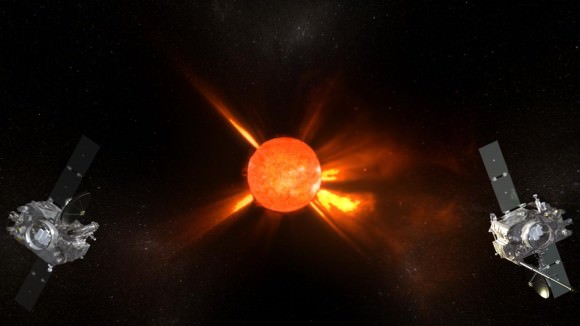
For the past 4 years, the two STEREO spacecraft have been moving away from the Earth and gaining a more complete picture of the sun. On February 9, 2011, NASA will hold a press conference to reveal the first ever images of the entire sun and discuss the importance of seeing all of our dynamic star.
Credit: NASA
The solar probes were launched together aboard a Delta II rocket from Launch Complex 17B at Cape Canaveral Air Force Station (CCAFS) in Florida on October 25, 2006. See Launch Video and Photos below.
Whole Solar Sphere A Goldmine for Science
I asked Pesnell and Guhathakurta to explain why this first ever whole Sun view is a significant scientific milestone.
“Until now there has always been an unseen part of the Sun,” Pesnell explained. “Although that unseen part has always rotated into view within a week or two, a global model must include all of the Sun to understand where the magnetic field goes through the surface.”
“Also, from the Earth we can see only one pole of the Sun at a time, while with STEREO we can see both poles at the same time.
“The next few years of overlapping coronal images will be a goldmine of information for predicting space weather at the Earth and understanding of how the Sun works. It is like getting the GOES images of the Earth for the first time. We haven’t missed a hurricane since, and now we won’t miss an active region on the Sun,” said Pesnell.
How will the science data collected be used to understand the sun and its magnetic field?
“Coronal loops trace out the magnetic field in the corona,” Pesnell elaborated. “Understanding how that magnetic field changes requires seeing where on the surface each loop starts and stops.”
Why is it important to image the entire Sun ?
“Once images of the entire Sun are available we can model the entire magnetic field of the Sun. This has become quite important as we are using STEREO and SDO to study how the entire magnetic field of the Sun reacts to the explosions of even small flares.”
“By seeing both poles we should be able to understand why the polar magnetic field is a good predictor of solar activity,” said Pesnell.
“Seeing both sides will help scientists make more accurate maps of global coronal magnetic field and topology as well as better forecasting of active regions – areas that produce solar storms – as they rotate on to the front side. Simultaneous observations with STEREO and SDO will help us study the sun as a complete whole and greatly help in studying the magnetic connectivity on the sun and sympathetic flares, ” Guhathakurta amplified.
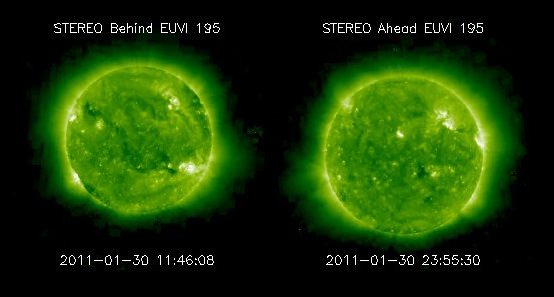
Watch a solar rotation animation here combining EUVI and SDO/AIA:
What is the role and contribution of NASA’s SDO mission and how will SDO observations be coordinated with STEREO?
“As the STEREO spacecraft drift around the Sun, SDO will fill in the gap on the near of the Sun,” explained Pesnell. “For the next 4 or more years we will watch the increase in sunspots we call Solar Cycle 24 from all sides of the Sun. SDO has made sure we are not doing calibration maneuvers for a few days around February 6.”
“On Feb 6th we will view 100% of the sun,” said Guhathakurta.
At a press conference on Feb. 9, 2011, NASA scientists will reveal something that no one has even seen – The first ever images of ‘The Entire Sun’. All 360 degrees
Watch the briefing on NASA TV at 2 PM EST
More about the SDO mission and SDO science
and Coronal holes from STEREO and SDO here
“3D Sun”
A STEREO Movie in Digital and IMAX was released in 2007
Watch the way cool 3D IMAX trailer below
STEREO spacecraft location map
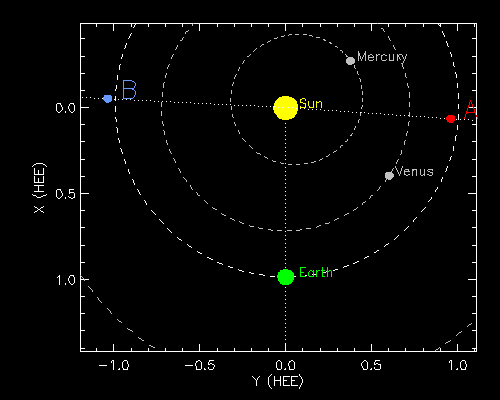
Caption: Positions of STEREO A and B for 31-Jan-2011 05:00 UT. The STEREO spacecraft are 179.2 degrees apart and about 90 degrees from Earth on Jan. 31, 2011. This figure plots the current positions of the STEREO Ahead (red) and Behind (blue) spacecraft relative to the Sun (yellow) and Earth (green). The dotted lines show the angular displacement from the Sun. Units are in A.U. (Astronomical Units). Credit: NASA
STEREO Launch Video
Launch Video Caption: The Delta II rocket lights the evening sky as STEREO heads into space on October 25, 2006 at 8:52 p.m. The Delta II rocket lights the evening sky as STEREO heads into space. STEREO (Solar Terrestrial Relations Observatory) is a multi-year mission using two nearly identical observatories, one ahead of Earth in its orbit and the other trailing behind. The duo will provide 3-D measurements of the sun and its flow of energy, enabling scientists to study the nature of coronal mass ejections and why they happen.
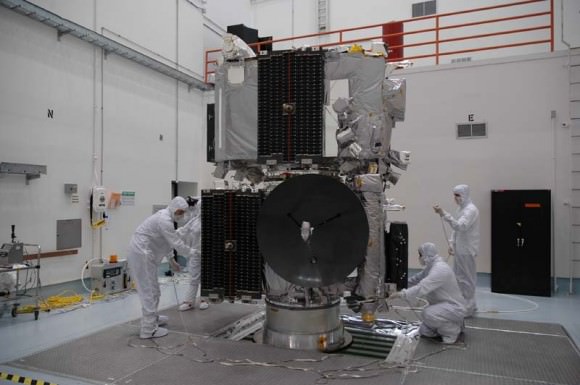
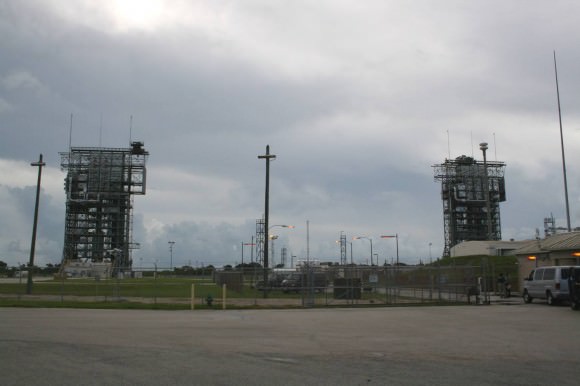
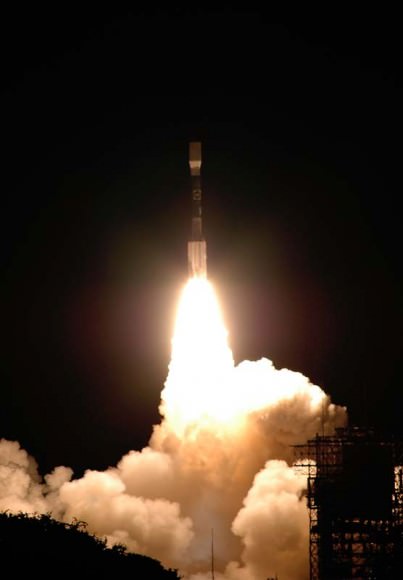
More STEREO Cleanroom and Launch photos from nasatech.net here
More about the SDO mission and SDO science
and Coronal holes from STEREO and SDO here
“3D Sun”
A STEREO Movie in Digital and IMAX was released in 2007
Watch the way cool 3D trailer here – Trailer narrated by NASA’s Madhulika Guhathakurta
— be sure to grab hold of your Red-Cyan Glasses

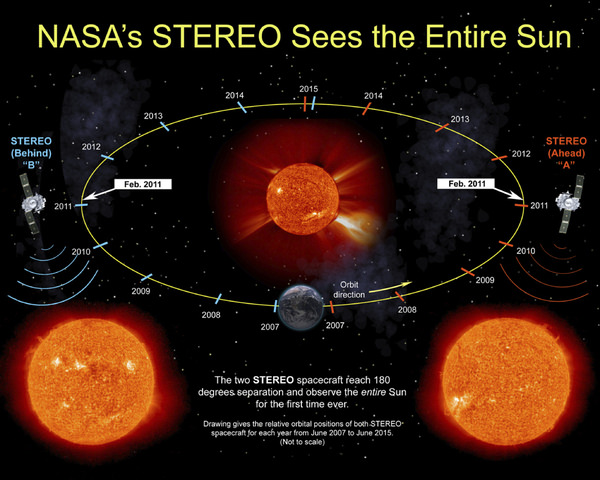
“The nearly identical STEREO spacecraft – dubbed STEREO Ahead and STEREO Behind – are orbiting the sun in opposite directions ”
As far as I’m aware, they’re not orbiting the Sun in opposite directions. It’s just that the orbital period of the ‘ahead’ craft is shorter than Earth’s (a ‘lower’ orbit), and the orbital period of the ‘behind’ craft is longer than Earth’s ( a ‘higher’ orbit). Hence the craft gradually separate out in azimuthal angle as viewed from the Sun, but they each orbit in the same sense…
3D Solar Seismology coming soon! WOW! Can’t wait to see the movie(s)!
Should make a good IMax show…
Indeed there is an excellent 3 D STEREO movie titled : “3D Sun” from 2007
in Digital and IMAX. see links here and added above:
http://www.3dsunfilm.com/index.html
Be sure to watch the IMAX 3 D Trailer ! with your red-cyan glasses – trailer narrated by NASA’s Madhulika Guhathakurta